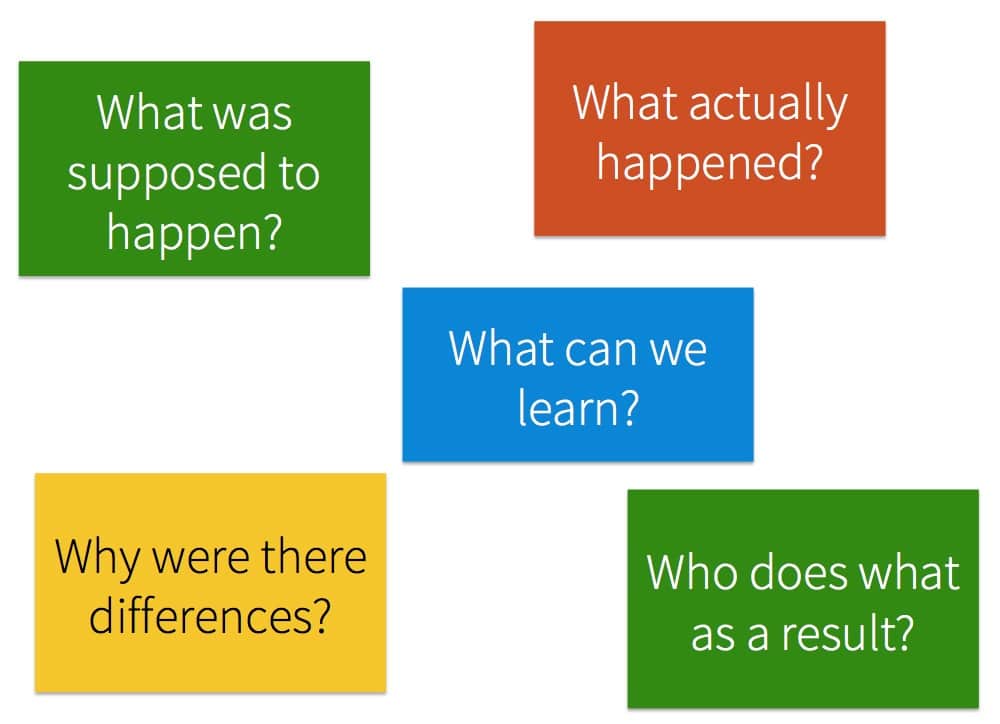The After Action Review (AAR) is a simple and highly effective way to create a project report using action planning and issue analysis.
It's ideal when you need to unpick what really happened in a project and build learning to drive improvement.
Objectives
- To bring together the relevant people to understand what really happened.
- To identify learning and use it, to continually improve.
- To create a project report and develop an action plan with actions, owners and timescales to drive sustainable change.
When Would You Use It?
- At the end meetings.
- During and post change initiatives and projects.
- To resolve complex customer complaints.
- Can be completed in 5 minutes at the end of a team meeting or take up to 2 hours for complex topics – it’s the latter application that’s described here.
- When you need to create a collaborative project report quickly.
Are There Any Rules?
- Ensure ALL the right people in the room – these are those who played a key role in the project/change initiative/customer complaint.
- Only disclose one question at a time.
- A commitment to open discussion is needed – ‘the elephant in the room’ to encourage openness and honesty, may help!
Resources Required
- A Facilitator – someone who can objectively and assertively lead the review, capture the key points and write them up on flip charts.
- Flip chart paper, pens and something to stick them on the walls.
- 1 sheet of flip chart paper for each question, using each question as a header – you’ll need lots more paper to capture all the input during the session.
- A room with lots of wall space to stick up each flip chart as it’s written.
Ground Rules
- Encourage a climate of openness and trust – based on the metaphor “there’s an elephant in the room” (a toy elephant in the room acts as a good prop for this).
- Everyone is on equal footing i.e. no hierarchy.
- Everyone freely participates.
- There is no finger-pointing or blame apportioned.
- What is shared in the AAR, is not attributed to a specific person, unless by agreement.
- Focus on facts.
Roles & Responsibilities
| Facilitator | Attendees |
|---|---|
| Does not provide any answers – complete objectivity is critical. | Those attending played a key role in the project/change initiative/customer complaint. |
| Ensures everyone’s view is heard. | Drive the actions that result from the workshop. |
| Ensures no blame is brought to the process. | |
| May be the team leader, a member of the team or depending on sensitivities, someone who has not been involved may be more appropriate. | |
| Must ensure that the AAR addresses the ‘real’ issues by guiding the conversation to the ‘business in question’. |
Process
The discussion addresses 5 questions in sequence...
- The Facilitator outlines the purpose of the activity – “to learn from and incorporate learning into future activities”.
- The Facilitator outlines how the process will unfold, without sharing the questions and sets the Ground Rules (see separate slide).
- The Facilitator asks the 1st question – “What was supposed to happen?” (i.e. what were the objectives). The Facilitator establishes how well the objective(s) were understood and capture all comments on flip chart. Place the flip chart/s where all can view.
- The Facilitator repeats step 3 for four further questions:
- “What actually happened?” to establish the facts about what happened in chronological order – the reality/ truth.
- “Why were there differences?” to analyse and interpret the activities. Comparing the objectives to what actually happened is where the real learning begins. Successes and shortfalls are discussed.
- “What can we learn?” to continue the analysis and interpretation.
- “Who does what as a result?” to develop an action plan with owners, actions and timescales to sustain successes and improve upon the shortfalls.

Secret Sauce
- In Question 2 strong facilitation is needed as participants are often keen to unwittingly deviate and provide answers to the questions that will follow.
- Also be aware of reactions and emotions, as question 2 is where blame can start to appear.
- Depending upon your business culture, be careful about mixing seniority of staff. It may prevent disclosure of information.
- For an AAR to be successful, it’s ESSENTIAL that:
- Everyone involved in the event freely participates.
- Everyone is on equal footing i.e. no hierarchy.
- There is a climate of openness and trust.
- There is no finger-pointing or culprit blaming.

